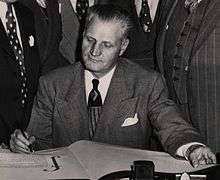Luther Youngdahl
| Luther Wallace Youngdahl | |
|---|---|
 Youngdahl in 1949 | |
| Judge of the United States District Court for the District of Columbia | |
|
In office August 29, 1951 – May 29, 1966 | |
| Appointed by | Harry S. Truman |
| Preceded by | Thomas Alan Goldsborough |
| Succeeded by | John Lewis Smith, Jr. |
| 27th Governor of Minnesota | |
|
In office January 8, 1947 – September 27, 1951 | |
| Lieutenant | C. Elmer Anderson |
| Preceded by | Edward John Thye |
| Succeeded by | C. Elmer Anderson |
| Personal details | |
| Born |
May 29, 1896 Minneapolis, Minnesota |
| Died |
June 21, 1978 (aged 82) Washington, D.C. |
| Political party | Republican |
| Spouse(s) | Irene Annet Engdahl |
| Alma mater |
Gustavus Adolphus College William Mitchell College of Law |
| Profession | Lawyer |
| Religion | Lutheran |
Luther Wallace Youngdahl (May 29, 1896 – June 21, 1978) was an American politician and judge from Minnesota. He served as an associate justice of the Minnesota Supreme Court from 1942 to 1946, then as Minnesota's 27th Governor from January 8, 1947 to September 27, 1951, and finally as a judge for the U.S. District Court for the District of Columbia from 1951 until his death in 1978.
Biography
One of ten children of a Minneapolis grocer, Youngdahl was a promising student at Gustavus Adolphus College in St. Peter, Minnesota, where he excelled in athletics and oratory and was active in campus government. Afterward, he attended William Mitchell College of Law (then the Minnesota College of Law). In 1930 Governor Theodore Christianson appointed the young lawyer to a municipal judgeship, the first of several judiciary positions he would hold before and after governing the state.
Politically, he was determined to rid the state of its pernicious gambling problem and he began, during the first of his three gubernatorial terms, by outlawing slot machines. Soon after dealing a sharp blow to racketeering, Youngdahl launched his "humanity in government" program. Appalled by the conditions of state mental hospitals, Youngdahl introduced a more humane concept of care. His sincere efforts to improve the lot of troubled youth, enhance public education, and give returning World War II veterans a financial boost earned this Republican administrator bipartisan respect and support. So popular was Youngdahl that he won each successive gubernatorial election by an ever-larger margin. That some conservatives found him "too liberal" didn't diminish his appeal or effectiveness.
Although Youngdahl, on the advice of his doctor, resigned as governor in 1952, he continued in public service as a federal judge in Washington, D.C. appointed by President Harry Truman. Truman made the appointment at the urging of Hubert Humphrey, partly out of concern for Youngdahl's health, and partly out of political calculation. Youngdahl later said of his judgeship: "Hubert was exuberant and happy. He was pleased that I could get to serve on the federal bench, and undoubtedly he was somewhat relieved that I would not be around to run against him" for the U.S. Senate in the 1954 election.[1]
In 1953, Youngdahl dismissed perjury charges against Owen Lattimore, a professor who had been charged with lying before a Senate Committee when he testified that he was unsympathetic to Communism. Youngdahl found that the indictment was too vague and that the prosecution would hinder free speech. In 1955, after new charges had been brought against Lattimore, Youngdahl again dismissed the charges on First Amendment grounds. After the United States Court of Appeals affirmed Youngdahl's decision, the case was dropped.
Long a believer in the benefits of rigorous exercise, Judge Youngdahl was still hearing cases and hiking four miles a day in his early eighties. He died in 1978 in Washington, D.C. and is buried in Arlington National Cemetery.
Youngdahl's son, Rev. L. William Youngdahl, was the subject of the documentary film A Time for Burning about efforts to integrate an all-white Omaha church in the mid-1960s.
Papers
Correspondence and miscellaneous papers relating to Youngdahl's appointment to the U.S. District Court for Washington, D.C. (1951–1967); correspondence and files relating to the Judicial Conference Committee on the Administration of the Probation System (1962–1967); photograph albums and scrapbook materials documenting his experiences as governor of Minnesota (1947–1951), his judicial service, and family activities; and some personal papers (1950–1968) are available for research use.[2]
References
- ↑ Obituary, Luther W. Youngdahl, Minneapolis Star-Tribune, June 22, 1978
- ↑ Luther W. Youngdahl papers
Other sources
- Esbjornson, Robert A Christian in Politics: Luther W. Youngdahl (1955)
External links
| Political offices | ||
|---|---|---|
| Preceded by Edward John Thye |
Governor of Minnesota 1947–1951 |
Succeeded by C. Elmer Anderson |
| Legal offices | ||
| Preceded by Thomas Alan Goldsborough |
Judge of the United States District Court for the District of Columbia 1951–1966 |
Succeeded by John Lewis Smith, Jr. |
